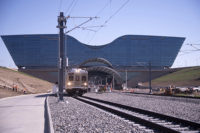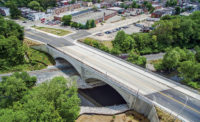Alot can happen in 95 days. Charged with replacing the Glenwood Springs, Colo., Grand Avenue Bridge in that short, inflexible timeframe, the project team had to get everything right the first time.
The Colorado Dept. of Transportation said 95 days was the maximum time the resort community on Colorado’s Western Slope could be without its primary road between downtown and the famed hot springs, across the Colorado River to the north.
Spanning a Union Pacific rail line, the river and Interstate 70, the existing nine-span, 676-ft-long bridge, built in 1953, suffered from numerous structural and functional deficiencies: narrow lanes, inadequate vertical clearances for railcars, closely spaced piers that created a pinch point on I-70 and insufficient scour protection on the spread footing of another pier, located in the river.
Few viable alternate routes exist through Glenwood Springs, so taking the crossing out of service for an extended period—even with the promise of a safer, modern replacement—was a disconcerting prospect. But years of CDOT’s planning and preparation achieved that goal with the fewest disruptions to the community’s quality of life.
According to Roland Wagner, CDOT project manager, consulting firm Jacobs led an environmental analysis that examined 13 alternatives and alignments. The final plan changed the bridge from a straight connection to a nearly 1,000-ft-long, curved alignment that improves connections with I-70.
The new bridge’s design allowed for rapid erection—a paramount issue for a community that had to find alternate ways to access businesses, commuter routes and emergency services.
“Public outreach was critical to everything we did,” Wagner says. “The plan constantly evolved and adapted to the community’s needs.”
Plan of Action
Working with its construction manager-general contractor (CM-GC)—a Granite Construction-RL Wadsworth joint venture—CDOT’s plan eventually became a multiphase, $76-million project. Greenwood Village-based Tsiouvaras Simmons Holderness (TSH) was responsible for the complex design.
Construction of the project’s initial phases began in January 2016.
TSH Transportation Engineering Manager Randal Lapsley characterizes the eight-span, 981.5-ft-long replacement structure, which rises 55 ft above the Colorado River’s low-flow level, as “a marriage of two bridge types.” Modeled using BSDI and Larsa 4D software, the new crossing is a five-span, 783-ft, 3-in., continuous steel trapezoidal tub-girder bridge. The curved girders have radii as tight as 603 ft. Each tub girder is supported by a pier composed of three diamond-shaped columns, eliminating the need for pier caps.
Supports and foundations for the girder section were installed first. After demolition of the old bridge, the remaining three-span, 198-ft, 3-in., cast-in-place concrete-slab section was built in Glenwood Springs’ space-constrained downtown area.
Applying a similar substructure strategy, the downtown section’s diamond-shaped columns framed directly into the slab and avoided the need for pier caps, while precast aesthetic treatments created an attractive backdrop for a planned community-events plaza below.
“Those ideas were evolving as we did the design, so we had to keep a lot of ideas in mind,” Lapsley adds.
The project team assessed a variety of obstacles to construction scheduling and phasing, and the Colorado River was the most critical challenge of all. With limited space to position cranes to erect the new bridge, Granite-RLW created more room on both shores by building causeways using more than 23,000 tons of rock and other material.
Because the larger, nearly 55-ft-wide south-shore causeway would be the river’s high-flow run-off area for two years, the team did extensive hydraulic modeling. They assessed possible interactions with seasonal flows and the extent of scouring on the existing bridge’s center pier. Even the timing of the causeway’s construction was contingent on the start of the trout spawning season.
“This was a big-risk item,” explains Gaylen Stewart, construction manager for Granite-RLW. “We had to be accurate or else wait another year to do the project.”
The team also built in contingencies for high-flow conditions. For example, if flows had approached 20,000 cfs, “we would have had to tear out the rock,” Stewart reports.
Wagner credits the CM-GC approach for helping the team to refine its strategies for all the project’s phases, including a schedule for the 95-day crossing closure. “On the one hand, having three years of planning allowed us to make decisions without being hurried,” Wagner says. “But the big thing was going out to the public and making them believe we could do it.”
The extensive public outreach program began with the environmental assessment and continued seamlessly as construction progressed toward the old bridge’s planned Aug. 14 closure. To ease the burden on Glenwood Springs’ few other routes, progress reports were augmented with suggestions for alternate transportation.
Along with causeway construction, the replacement project’s initial work included street improvements, a portion of the new I-70 connection and construction of a five-span, 576-ft-long steel-girder pedestrian bridge. Founded on 12-in. micropiles and 48-in. and 78-in. caissons, the 18-ft to 36-ft-wide structure, designed by AMC Foster Wheeler, also supports some of the utilities that were previously routed along the old highway bridge.
For the girder section of the replacement structure, Granite-RLW built foundations using drilled 60-in. and 78-in. caissons. The location and design of the foundations were carefully selected to avoid any potential conflict with the subterranean waterways that feed the hot springs. The downtown cast-in-place structure is built on spread footings that measure 4 ft x 9 ft x 27 ft at each column, with two columns per location.
Progress … and a Crash
Granite-RLW put nearly 40% of the new girder substructure in place before the old structure was closed, then demolition subcontractor Cherry Creek Recycling began what was scheduled to be a two-week teardown. On the evening of the second day, backhoes were pulling girders away from a pier near the downtown side of the river when the pier unexpectedly failed, resulting in a 210-ft span of girders tumbling to the ground and blocking the railroad tracks.
No injuries resulted from the incident, and the tracks were cleared in a matter of hours, with no disruption to rail traffic. As the girders fell, however, they damaged some of the exposed rebar on the unfinished substructure.
“That’s just part of the risk of building so close to an old structure,” Stewart says, adding that the subcontractor followed all required demolition and safety protocols. After assessing the damage, “the repair plan was ready in 12 hours, and our schedule wasn’t affected,” he says.
The unexpected girder collapse proved to be the only significant construction-related incident during the closure. Racing the calendar with nearly round-the-clock construction activity, Granite-RLW erected the remaining two spans of the girder section and all the cast-in-place substructure before pouring the 3.3-in. to 9-in.-thick deck.
CDOT and the project team determined the functionally complete bridge could be opened 10 days ahead of schedule, earning Granite-RLW a $250,000 bonus.
“We really weren’t sure how the community would react when the opening date was announced,” says Pat Kalisz, project manager for Granite. Indeed, a ceremony originally expected to attract only a few hundred people was nearly overwhelmed by 3,000 residents who were eager to walk across the new structure before it opened to traffic.
“It just shows how important the project was to them and how closely they followed its progress,” Kalisz adds.
Granite-RLW will complete the 30-month replacement project next year, after construction of an I-70 ramp and an associated retaining wall, removal of the causeways, completion of electrical work and the addition of a 1-in.-thick polyester bridge-deck overlay.
Although there is plenty of credit to be shared on the project, Glenwood Springs city engineer Terri Partch sums up the feelings of many in describing how CDOT and Granite-RLW kept the community’s needs interests at heart. “This could have been the worst thing to ever happen to the city,” Partch says. “Instead, they did everything possible to move things along and keep everyone informed. Their level of effort was a real game-changer.”










Post a comment to this article
Report Abusive Comment